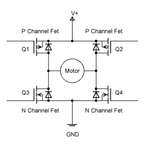ud23
Advanced Member level 3
The supply of the mosfets in the project is wrong, you have used VEE which is a -5v supply, if you replace it with Vcc or any other positive supply it works fine.
Alex
hi set value of VEE is 12 v in my setting
---------- Post added at 13:04 ---------- Previous post was at 12:59 ----------
hi can i use fly back diode at output, so which diode is suitable for it can i use 1n4007(1amp) or other for high current up to 3 amp????. will schotky diode use as fly back diode for back emf protection.?????



